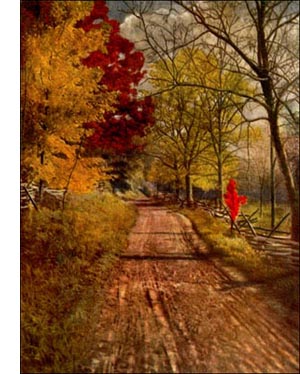Cottonwood Poplar Tree
 Cottonwood (Populus deltoidea, Marsh.)-Much-branched tree, 60 to 150 feet in height; diameter 5 to 7 1/2 feet. Bark deeply furrowed, grey-brown, becoming greenish; often ashen grey on old trees. Wood dark brown; sap wood white; weak, compact, light. Buds large, pointed, resinous. Leaves broadly ovate, taper pointed, 3 to 5 inches long, margin wavy and coarsely toothed, thick, shining, paler beneath, yellow in fall; petiole long, slender, flat, red or yellow. Flowers, March, in pendant catkins, 3 to 5 inches long, loosely flowered; staminate red, numerous; pistillate green, sparse on trees. Fruits, May, aments 6 to 12 inches long; capsules ovate, often curved, 2-valved; seeds in white, cottony mass. Preferred habitat, moist soil along streams. Distribution, Quebec to Northwest Territory; south to Florida; west to Colorado and New Mexico. Uses: Much planted for shade and windbreaks in the prairie states. Wood has recently come into use in making packing cases.
Cottonwood (Populus deltoidea, Marsh.)-Much-branched tree, 60 to 150 feet in height; diameter 5 to 7 1/2 feet. Bark deeply furrowed, grey-brown, becoming greenish; often ashen grey on old trees. Wood dark brown; sap wood white; weak, compact, light. Buds large, pointed, resinous. Leaves broadly ovate, taper pointed, 3 to 5 inches long, margin wavy and coarsely toothed, thick, shining, paler beneath, yellow in fall; petiole long, slender, flat, red or yellow. Flowers, March, in pendant catkins, 3 to 5 inches long, loosely flowered; staminate red, numerous; pistillate green, sparse on trees. Fruits, May, aments 6 to 12 inches long; capsules ovate, often curved, 2-valved; seeds in white, cottony mass. Preferred habitat, moist soil along streams. Distribution, Quebec to Northwest Territory; south to Florida; west to Colorado and New Mexico. Uses: Much planted for shade and windbreaks in the prairie states. Wood has recently come into use in making packing cases.We all concede that the cottonwood has faults. The brittle wood cannot withstand the winds, the leaves drop untidily through the summer, the cast-off staminate catkins are a nuisance in spring, and the fluffy cottony seeds shed so deliberately in early summer by the fertile trees fill the air and the meshes of door and window screens to the exasperation of the whole neighbourhood.
But go out into one of the little breathing spaces called parks in a great city like New York in the early spring days when the children of the tenements and the stuffy flats are brought out for a first breath of the spring air. The old cottonwood has its buds all a-glisten with promise, and in a few days longer the dainty little leaves twinkle all over the treetop with the most cheerful green. In the late summer, in spite of its losses, the tree still carries a bright green crown of shade which turns yellow before it falls. With all its faults, it endures the heat of cities, and the dust and soot with commendable patience. In the protection of great buildings it does not suffer by winds as it does in exposed situations.
There are better, longer-lived trees for the open country, but in cities the cottonwood has a use and a message of cheer for rich and poor who look up and learn to know the tree. Unlike the variety next described, the cottonwood takes on dignity with added years.
The Cottonwood (P. Fremontii, Wats.) grows in western California, from Sacramento south, and eastward to Colorado and Texas. It is a favourite shade tree, and an important source of fuel. Cut back systematically, the trees produce abundant crowns of suckers in a very short time. Fremont's cottonwood is distinguishable from the preceding species by the smaller size of its leaves and the pubescence of its buds. Its leaves are sometimes kidney shaped. The bark of old trees is reddish brown. The trees reach 100 feet in height.
The Cottonwood (P. Wislizeni, Sarg.) of the Rio Grande Valley in Texas and New Mexico, is a large, wide-crowned tree, with Stout, smooth, orange-coloured twigs and leathery, yellowgreen leaves. Without these distinguishing characters it might easily be confused with the two species List described. The tree is not met with outside its natural range.